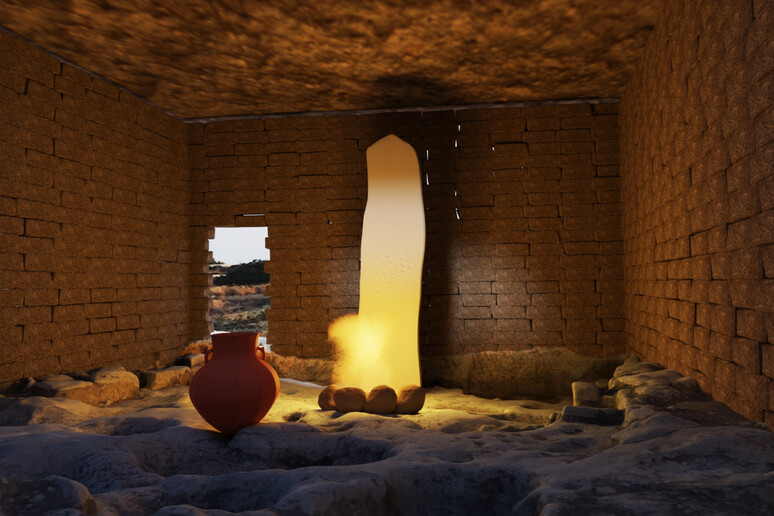(by Silvia Lambertucci).
Lights and shade alternating in a large dark room, the tongues
of fire of a brazier lighting up, day and night, the smooth,
dark stone of a colossal monolith.
While in the other parts of the great workshop, dozens of people
are at work spindling, weaving and dyeing textiles to be traded
with all the then known world.
Discovered by an Italian mission, the Erimi Archaeological
Project of the University of Siena, a temple from 4,000 years
ago is re-emerging on Cyprus.
"It's the oldest sacred space ever found on the island,"
archaeologist Luca Bombardieri tells ANSA in a sneak preview.
He
has been leading the digs for15 years, carried out in
collaboration with the Department of Antiquities of Cyprus and
the ministry of foreign affairs and international cooperation.
It is, in fact, a sort of 'temple before a temple', a place for
the holy set out inside the working environment, which sheds
fresh light on the extraordinarily well-articulated and 'modern'
life of this community of artisans who lived four millennia
before us, just a few centuries before the first cities were
born on the island in the heart of the Mediterranean.
But that's not all.
Among the novelties of the latest fortunate
excavation campaign, there is also a cold case pregnant with
disquieting mystery: the remains of a young woman killed and
walled up at home, perhaps so that her ghost would not come back
and disturb the living.
The femicide "may be linked to other cases recorded in the past
in other parts of Cyprus," says the archaeologist.
The victims were always young women. Killed and separated from
their communities, held far from even the dead, the expert
thinks, "perhaps for issues linked to maternity".
The girl of Erimi was not more than 20 years old. Her killers
smashed in her skull, with a lance or a rock. Then they laid her
body on the ground, placing a heavy stone on her breast "as if
to keep her still", says Bombardieri. There are no accompanying
grave goods next to her, nothing that makes one think of a
normal burial. The door of the small dwelling, on the other
hand, was sealed with care, just like that of a tomb. We are in
the Bronze Age, between 2000 and 1600 BCE.
With its over 1,000 square metres of workshops, warehouses and
large dyeing vats, the Erimi atelier occupied the entire summit
of a hill on the southern coast of Cyprus, not far from the
modern city of Limassol. An ideal position for the activity that
animated it, always well ventilated and a stone's throw from the
fresh water of a river, with earth where plants grew
spontaneously that served to dye the textiles that beautiful red
colour that made them unique and precious.
A little farther down, huddled one against the other, there were
the homes. Still farther down, at a due distance, the dead were
buried, the richest in large chamber tombs filled with grave
goods, and the poor in plain ditches.
The temple was in the innermost part of the atelier and in order
to get to it you had to go through the working sections. But
here, with respect to the rooms in which people were busy with
spindles and looms, the atmosphere must have been very
different, with the monolith, over two metres tall, which stood
proud in the centre of the room. In front of the stone there
were just the brazier and a large amphora, full of water
perhaps, which, Bombardieri reckons, must have been used for the
rituals linked to the cult. It is not clear if there was a
full-blown priest, he explains, and it is likely that the ones
guaranteeing the link with the divinity was the same person or
group of people who led the productive activities and the whole
community. A clan whose importance has been found in one of the
richest tombs of the necropolis, immediately outside the tall
ring of stone and wooden walls which, at least in the final
phase of its history, protected the village from enemy attacks
and at the same time exalted its importance, making it visible
from land and sea.
Thanks to those wine-coloured textiles, Erimi had grown in fame
and power. And perhaps, who knows, together with the new wealth,
enemies also came, internal and external. The fact remains that
its history suddenly ends, the village is abandoned and the
atelier sealed off with all its precious trove of objects,
including the temple with its monolith. A fire, perhaps set off
by the fleeing villagers, brings its roof crashing down. And
paradoxically, it is the very act of abandonment that hands down
the adventurous story of these skilled weavers.
"The collapse of the structure, sealing off those remains, has
enabled us archaeologists to rediscover them after four thousand
years," says Bombardieri.
And to tell the story of an exceptional community and a village
that had almost become a city.
And who knows if the next digs won't help us understand more
about the mystery of the murdered maiden and the others, at
least 15, who more or less in the same time, in various parts of
the island, seem to have shared her fate.
ALL RIGHTS RESERVED © Copyright ANSA











